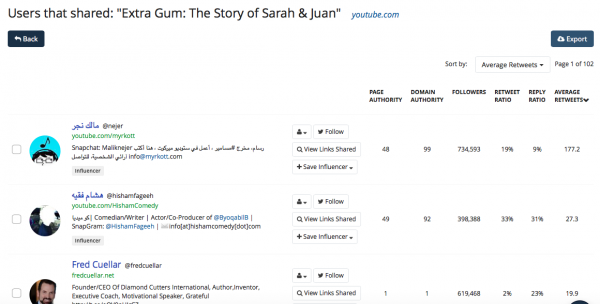Advertisement
Time to face up to reality:
You can have a great business mind, an awesome website and the prettiest blog design in the world, but if you don't promote your content properly, you're making a HUGE mistake.
Content promotion is the most underrated, undervalued and underused part of content marketing.
End of.
You see, it's okay for the big websites.
They get their content shared, sometimes without it even being read.
They get the links.
They get the rankings.
They get the email subscribers.
And all without lifting a finger.
Pretty unfair, eh?
But for the majority of us, we must work hard on promoting what we've created.
Very hard.
Not great news, obviously, but there's no getting around it: that's the only way you're going to be able to grow your business with content marketing.
Fail to promote your content and at best you're leaving profit on the table for someone else to hoover up.
At worst, you're committing digital suicide.

Content promotion: here's the bad news.
Content promotion is tough.
It takes skill, it's time consuming and it's not very scalable.
Don't be mistaken. Content promotion isn't about opening up your favourite social media platforms and firing out a few links.
And be honest: that's the way you've always done it, isn't it?
Surely you must have seen that a handful of tweets and posts only gets you a small, temporary spike in traffic?
That social media cycle is soon over.
The minimal fuss soon dies down.
So, the content promotion I'm talking about is much more advanced. Our strategies take days, if not weeks, to execute…
… but they work.
I can't find the motivation for you, but I can help with the strategy:
Stay tuned – further down this post are 7 killer methods for promoting your content like a boss.
Content promotion: here's the good news.
It's not all doom and gloom.
Because it's a right old slog at times, guess how many people promote their content [beyond relying on the usual, lazy ways]?
Hardly anyone.
And that means you've got a great opportunity.
Don't be put off by the prospect of putting a shift in, because it'll pay off handsomely.
We're not just talking about getting ahead of your rivals; you'll be storming past them, leaving them eating your dust.
What's the simple reason why you must promote your content?
Traffic.
Simple as.
Your business is gagging for traffic, whether you know it or not.
You need to get as many eyeballs on your website as possible.
That's the only way you're going to get the shares, links, rankings, email subscribers, leads, customers and profit you're after.
At Splash Copywriters, we treat every type of blog post like a book launch.
That's why we don't publish blog posts too often – because they all require a lot of promotion… and that takes time.
Perhaps you've been kidded into thinking that you have to consistently publish a lot of content in order for your content marketing strategy to work?
You see this 'tip' all the time: if you want a better blog, then blog more often.
That's not true.
[It's actually incredibly unhelpful.]
Our business has grown because we publish infrequently, not in spite of it.
And content promotion is at the heart of our success.
9 ways you can become the Don King of content marketing.

Method 1: Submit your post in forums.
Of course, posting a link to your article through the normal social media channels is a good idea.
But there are a bunch of similar, related opportunities you can tap into too.
Basically, this is all about common sense. You have a target audience. Where do they hang out? How can you get your brand in front of them?
You're looking for anywhere where there's a community of people who could be interested in what you have to say.
Typically, we're talking about any forums for your industry [hint: there's pretty much a forum out there on every topic under the sun.
Just get searching:

If your content is published in this way, it'll attract attention and encourage engagement, so you don't have to annoy someone with a pushy marketing message.
Instead, this is content marketing at its best.
Method 2: Embrace the power of email marketing.
One of the best things you can do with your article is tell your email list about it.
[And if you don't have an email list, start building one.]
After all, these people have connected with you, bought from you and opted to hear from you…
… if they're not interested in what you've got to say then who will be?
Simply choose what you feel is the most interesting point that you make in your blog post and include a snippet of the story within your email.
That should be enough to pique their curiosity and hoover up a few clicks and shares.
Method 3: Mention an influencer and leverage their audience.
Why not contact someone who is hugely influential in your area of expertise?
You could get in touch with them [via email or social media] tell them about your piece and grab a quote about the topic you've written about.
"Please give me a quote and help me get loads of shares and I'll say you're great."
It's an effective strategy because influencers love to showcase themselves.
So when you've worked in their short quote, give them a link to the piece so that they can get it in front of their audience and help you promote it.

If you've picked someone with a huge audience, this is an amazing way of boosting traffic, shares and newsletter signups.
Method 4: Speculate to accumulate with paid ads.
Paid ads, particularly with Facebook, are really underrated.
I guess most people are either scared to put any money behind a blog post, or they're unconvinced about the ROI they'll get from it.
But here's the thing:
If you've clearly defined your target audience then you can advertise your content to a very specific demographic.
And, considering you can set your own strict budget restrictions, is there really anything to lose?
What if spending $50 on promoting a post earned you 100s of shares and email subscriptions?
Would it be worth it then?
Method 5: Repurpose your content to appeal to a new, wider audience.
We're all different.
And we all like to consume our content differently.
But you're savvy – you're already reaching out to your target audience in the right ways because you've carefully profiled your traffic.
You understand them. You know what makes the tick.
But perhaps if you tweak your content a little, you could draw in some new prospects?

Why not turn your blog post into a video and post it on YouTube?
What about into PowerPoint for SlideShare?
Would it work as an infographic?
Maybe even an animation?
The point being: don't limit yourself to text.
Method 6: Contact people who've shown form.
A sure-fire way to kick-start any promotion is to head straight for anyone who has shared similar content on social media before.
It's a no-brainer: they've got previous, which drastically improves your chances of success.
There are a couple of ways of finding out who you should be targeting.
You can do it the old-school way and do it manually. Obviously this'll be free, but it will make what is already a long process even longer.
So I'd always advocate using a tool – especially if you're going to be doing this regularly.
A good tool can give you the information you need in super-quick time.
I use Buzzsumo.
Want to see it in action?
Firstly, just type in a topic:

Then choose any of the results and click on 'View Sharers':

This then brings up a list of everyone who has shared this article on Twitter.
Ever.

Handy, eh?
It makes our job far easier than it was 2 minutes previously.
Simply track them down on Twitter or Facebook and see if they'll share your piece too.
Method 7: Actually tell Google that you've just published something.
If there's one thing about Google that you must realise, then it's this:
It's a machine.
And machines are imperfect.
That means that although Google is extremely clever and is very likely to come across your blog posts, you can't rely on them to do so.
They can – and do – miss things.
But there is something you can do.
Whenever I've written and published a new blog post, my first job is always to log into Google Search Console.
I find my website and open up my account. Then I click on 'Crawl':

Once that option has been expanded, I go to 'Fetch as Google':

Then you merely fill in the URL of your new post and click on 'Fetch and render':

So, when I did this for my copywriting tips post, I'd have seen this:

This small 2-minute job removes the chance that Google will miss your post, so it's crucial.
Method 8: Reach out to commenters.
Comments on a blog post are a great indication of a popular blog. It's really hard to generate the type of engage that results in a discussion.
But such blogs do exist [some generate huge amounts of comments].
And there's something important that we can conclude about anyone who has left a comment on a blog post…
… they are really interested in that topic.
So a great promotion tactic is to curate a list of popular blogs, the ones that get these comments.
Run each post through import.io and scrape the commenter data.
From that information, you can pull out the email addresses of anyone who has left a comment. Then, all you have to do is send them a polite email letting them know about your post.
Just make sure that you approach them in a friendly, non-intrusive way. Let them know that you noticed that they've shown an interest in [insert topic] and that your latest post might be of interest.
Leave it at that.
Don't ask for anything; the message is more effective when you just pique their interest.
Method 9: Post your article in active groups.
There are all sorts of great groups on social media that you can publish your article in.
Take Facebook for instance.
Enter a term into the search bar. In the example below, I've entered 'content marketing':

Then click on 'Groups' to see all the relevant groups for that term:

You'll see a mixture of groups.
Some will be public [and you'll be able to post immediately], others will be private [so you'll need to request permission to join].
Either way, I'd recommend not firing in a promotional post immediately.
Instead, take a couple of minutes to read the group rules.
Perhaps also respond [helpfully] to a few existing posts.
[I guess you could call it social media etiquette.]
Similarly, LinkedIn is a great place for groups. Again, enter a term into the search bar:

Then click on 'Groups':

Depending on your niche, you could see quite a few opportunities:

Groups are a great way of reaching out to a whole new audience.
One final tip for after you've promoted your content.
When you've flogged your piece as much as you can and you've squeezed every ounce of ROI out of your post, there's one more job to do:
Insert internal links into your post after the page has done well.
We do this for a couple of reasons.
Firstly, if your post is really good, then it should stand the test of time.
That is to say, it probably won't just generate traffic today; it'll probably work hard for your business for a very long time.
[Particularly if you've done your keyword research properly.]
Therefore, you want to make the most of the opportunity by using internal links to casually promote other articles you've written or relevant web pages.
Perhaps even your products or services too.
Secondly, if your post is doing well in search, by inserting internal links, we can pass some of the link juice through to our other web pages.
'Link juice' just refers to the power or equity that's been passed to a web page [via content promotion].
In essence, some of the credibility of your post can be diluted through to the rest of your site. This could result in product or service pages ranking higher too.
However, the big thing to remember is this:
Don't do this until your post has done well.
Too many internal links can be distracting and appear a little 'salesy', which will make promoting the piece harder.
But now you're set.
You've spent ages on your blog post.
You've worked hard.
So reap the rewards you deserve.
Vicki Press is an experienced copywriter who has written words for some of the UK's biggest brands, such as Sky, Three and Vodafone. She now helps copywriters find work and improve their skills.
Source:
The shocking truth about blogging and content marketing



































